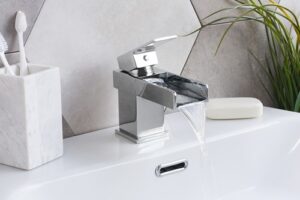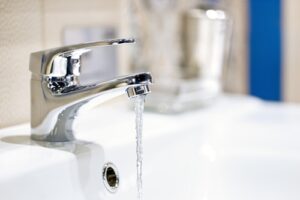Bathroom faucets tend to be overlooked as a seemingly small fixture with little impact on both functionality and aesthetics in any residential space. Yet, when a homeowner does not have a faucet that works, or that is working properly, it can be seen as a much more important addition to a home than most people may realize.
Whether you’re looking to enhance the style of your bathroom or simply seeking an upgrade to improve efficiency, embarking on the journey of replacing or upgrading your bathroom faucet can be a rewarding endeavor. However, amidst the myriad of options available in the market, navigating this process can sometimes feel overwhelming.
Some people might get stressed out or anxious about replacing a bathroom faucet, but fear not, for in this comprehensive guide, we delve into the intricacies of handling the upgrade or replacement of your residential bathroom faucet with confidence and ease. 
From understanding the different types of faucets to mastering the installation process, we equip you with the knowledge and insights necessary to make informed decisions and achieve the bathroom of your dreams.
What Issues Can Cause a Faucet to Need to be Replaced?
In most cases, a bathroom faucet will not break or stop working as it once did all of a sudden. There are very logical reasons why a bathroom faucet might be slowly degrading over time after many years of use by residential homeowners. In fact, there are many different issues that would prompt homeowners to consider upgrading or replacing the faucet in their bathroom.
Mineral Buildup: Hard water contains minerals like calcium and magnesium, which can accumulate inside the faucet, leading to limescale buildup. This buildup can obstruct water flow, affect the operation of the faucet handle, and cause leaks.
Mineral buildup is something that can be dealt with by homeowners before it becomes too big of a problem. For example, having faucets and their parts submerged in an acidic substance like vinegar can have a drastic effect on mineral build up. THis is something that should be done every now and then, and it even works great on shower heads as well.
Corrosion: Exposure to water, especially if it’s acidic or contains chlorine or other chemicals, can cause corrosion of the faucet materials over time. Corrosion weakens the structure of the faucet, leading to leaks and reduced functionality.
Corrosion is something that typically does not affect the sink because it is not made from a metal material.
Wear and Tear: Daily use of the faucet, including turning the handle on and off and adjusting water temperature, can lead to wear and tear of the internal components such as seals, gaskets, and valves. This wear can cause leaks, dripping, and loss of water pressure.
Faulty Installation: Improper installation of the faucet or using low-quality materials can contribute to premature degradation. If the faucet is not securely mounted or if connections are not properly sealed, it can lead to leaks and other issues over time.
Quality of Materials: The quality of materials used in the manufacturing of the faucet can significantly impact its longevity. Faucets made from cheap or inferior materials may degrade more quickly than those made from higher quality materials such as solid brass or stainless steel.
External Factors: Environmental factors such as exposure to sunlight, extreme temperatures, or abrasive cleaning agents can also contribute to the degradation of a bathroom faucet over time.
Addressing these factors through regular maintenance, proper installation, and choosing high-quality materials can help extend the lifespan of a bathroom faucet and prevent premature degradation.
What Parts of a Faucet Can Be Replaced Without Getting a Whole New One?
A bathroom faucet consists of several components that can be replaced individually to address specific issues or to upgrade the faucet. A new faucet will come with all of these parts when for installation, but an existing faucet may have parts that are still in working order, and do not need to be replaced.
Knowing this aspect about faucet upgrading or replacement can end up saving homeowners money on renovations, as buying a whole new facet assembly may not be necessary. Here is a list of some of the parts that work together to make sure that a facet is working properly.
Handles or Knobs: These are the parts of the faucet that you use to turn the water on and off and adjust the water temperature. Handles can be replaced if they become loose, damaged, or if you want to change the style of your faucet.
Faucet handles or knobs all serve the same function and essentially work in the same way. The major difference between different types of faucet handles or knobs is how they look, and the aesthetic qualities of them from different shapes and materials used.
Cartridge or Valve: The cartridge or valve controls the flow and temperature of the water. If you’re experiencing leaks, dripping, or difficulty in controlling the water flow, replacing the cartridge or valve can often solve these issues. Keep in mind that different types of faucets will not have this.
Aerator: The aerator is the small mesh screen located at the end of the faucet spout. It helps regulate the water flow and reduce splashing. If the water flow is irregular or if the faucet is spraying water unevenly, replacing the aerator can often resolve these issues.
Spout: The spout is the part of the faucet from which the water flows. If the spout is leaking or if you want to upgrade to a different style, you can replace it without replacing the entire faucet.
Supply Lines: These are the flexible hoses that connect the faucet to the water supply lines. If the supply lines are leaking or damaged, they can be replaced to prevent water damage and ensure proper functioning of the faucet.
O-rings, Seals, and Washers: These small rubber components are used to create a watertight seal between different parts of the faucet. Over time, they may wear out or become damaged, leading to leaks. Replacing these components can often stop leaks and restore the faucet’s functionality.
Mounting Hardware: If the faucet is not securely mounted to the sink or countertop, it may wobble or leak around the base. Replacing the mounting hardware, such as screws or nuts, can help stabilize the faucet and prevent leaks.
By replacing these individual components as needed, you can prolong the lifespan of your faucet and address common issues without having to replace the entire fixture.
Consider Faucet Upgrades and Replacements From a Professional Plumber
When it comes to faucet upgrades and replacements, seeking assistance from a professional can offer numerous benefits, ensuring a smooth and successful transition. Here are some reasons why consulting a professional for faucet upgrades and replacements is advantageous.
Expertise and Experience: Professional plumbers have the knowledge and experience to assess your specific needs and recommend the most suitable faucet options based on factors such as your bathroom layout, water pressure, and usage requirements. Their expertise ensures that you select a faucet that not only fits your aesthetic preferences but also functions optimally in your space.
Proper Installation: Installing a new faucet involves more than just swapping out the old fixture for a new one. Professional plumbers have the skills and tools necessary to install the faucet correctly, ensuring a watertight seal and proper alignment. Proper installation not only prevents leaks and water damage but also maximizes the lifespan of your new faucet.
Access to High-Quality Products: Professional plumbers often have access to a wide range of high-quality faucet brands and models that may not be readily available to consumers. They can recommend reputable brands known for their durability, reliability, and performance, ensuring that you invest in a faucet that will stand the test of time.
Compliance with Building Codes: Building codes and regulations govern the installation of plumbing fixtures to ensure safety and compliance with industry standards. Professional plumbers are familiar with local building codes and regulations and can ensure that your faucet upgrade or replacement meets all necessary requirements.
Warranty Coverage: Many faucet manufacturers offer warranties on their products, covering defects in materials and workmanship for a specified period. By having your faucet installed by a professional, you can often benefit from extended warranty coverage and peace of mind knowing that any potential issues will be addressed promptly.
Overall, consulting a professional plumber for faucet upgrades and replacements provides you with the expertise, assurance, and peace of mind needed to achieve the desired results efficiently and effectively. Whether you’re looking to enhance the aesthetics of your bathroom or improve functionality, partnering with a professional ensures that your faucet upgrade or replacement project is handled with care and precision from start to finish.
In the journey of enhancing your residential bathroom, few endeavors offer as much impact with relative simplicity as upgrading or replacing your faucet. Throughout this comprehensive guide, we’ve explored the intricacies of handling this task with confidence and finesse, ensuring that your bathroom transformation is both seamless and rewarding.
From understanding the different types of faucets to navigating the selection process based on functionality and aesthetics, you’ve been equipped with the knowledge to make informed decisions that align with your unique preferences and needs. Moreover, by delving into the various factors that can contribute to faucet degradation over time, you’re now empowered to take proactive measures to extend the lifespan of your new fixture.
Whether you choose to embark on this journey independently or enlist the expertise of a professional plumber, the key takeaway remains the same: upgrading or replacing your residential bathroom faucet is an opportunity to elevate both the form and function of your space. By investing in quality materials, proper installation, and regular maintenance, you can ensure that your faucet continues to serve as a reliable centerpiece of your bathroom for years to come.
